Chipps takes a visit to the land where puffas are made.
Back when the weather was warm, I took the train from Todmorden to the Manchester suburb of Stalybridge (Edit: OK, it’s actually in Tameside, but unless you’re northern, who’s heard of that, eh?). Previously, Stalybridge had only ever been known to be for being the birth place of the only northern boy at my Somerset school. However, it’s got more going for it than that. For a start it has the longest pub name in Britain: The Old Thirteenth Cheshire Astley Volunteer Rifleman Corps Inn and the turf at the footy club was rumoured to be cousins with that of Wembley. That’s not why I’m here though. I’m here to see PHD and to look at how it make its down jackets and sleeping bags.
Navigating my way through the red corporation brick buildings of old Stalybridge, it seems a seemingly suitable place for a hands-on clothing manufacturer to still be based. In fact PHD are one of two companies that still hand-makes down products in Europe (the other is in Eastern Europe). I find the PHD factory in an old industrial mill building, heading through the courtyard and past the comfortingly oily smell of engine machine shops and up the stone steps to a modest door – and back a couple of decades into a proper old school manufacturing factory.
Peter Elliot, the manager, meets me at the door and gets me a coffee while I have a quick nose around.
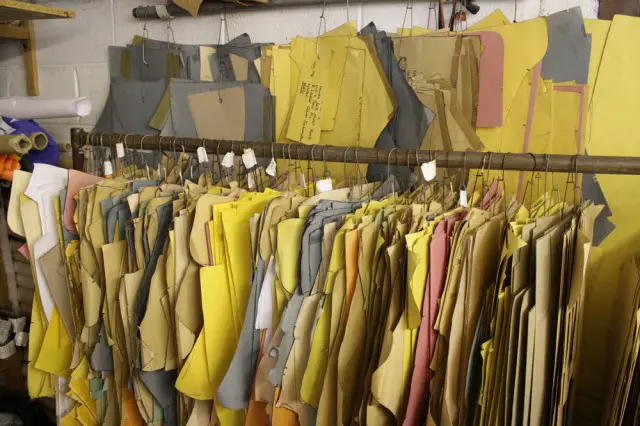
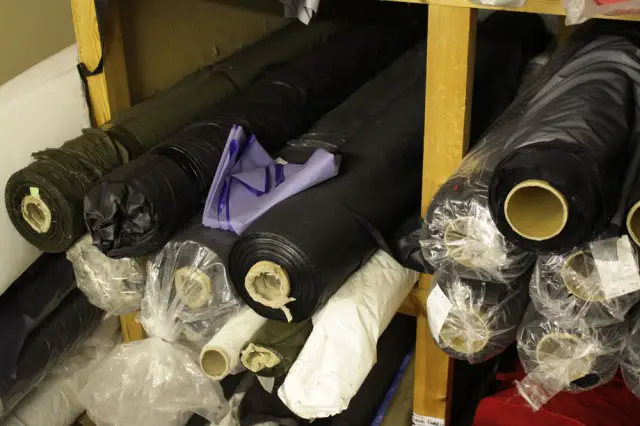
‘Low-tech’ and ‘hands on’ come to mind… the old brick walls are lined with years of manufacturing clutter, rolls of fabric, poster and calendars of assorted age and bits of tinsel decorate the seamstresses’ sewing machines. Like most ground-up manufacturing places I’ve ever been to, though (Hope, Brooks, Salsa, DT Swiss among others) the less glamorous-looking the manufacturing process, often it produces the shiniest final product.
PHD was set up by Peter Hutchinson (PHD = Peter Hutchinson Designs) who was a climber in the ’50s and a contemporary of Don Whillans and Joe Brown and also the Ox-Bridge set of early mountain climbing pioneers. He moved up north to climb and started to make his own ‘duvet’ down jackets for trips to the Alps, purely to save money. As is often the case, friends started putting in their own orders.
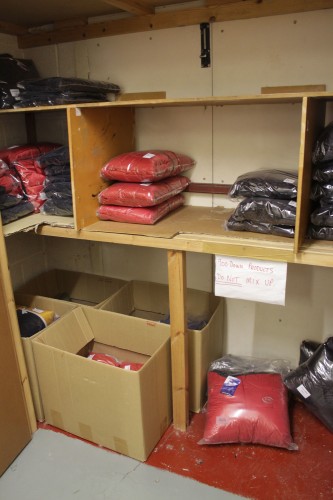

Peter made a couple of bags for Joe, Don and Chris Bonington and sold a few more on the back of it. John North remembers ordering a ‘duvet’ from Peter. “You had to pay half of it up front, so he could buy the materials, and then half when he’d finished it. I still have it.” He started off living in a hen hut on a farm and set up making bags for a (meagre) living. Ten years later he was making kit for the sharp end of the climbing world, outfitting missions to the North and South Poles and the Himalayas.

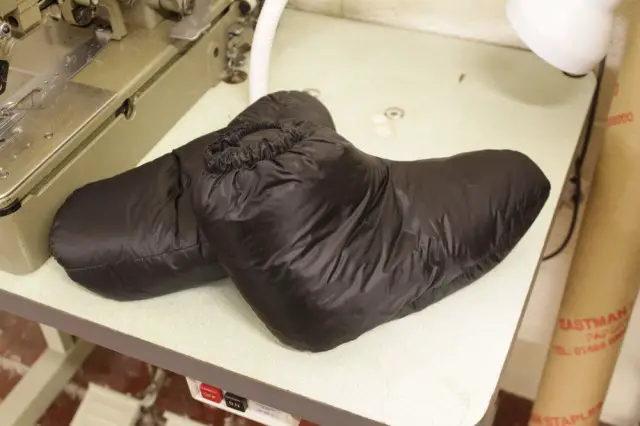


In the ’70s, the commercial outdoor world started to grow, with outfitters like Blacks, Field and Trek starting up and Ellis Brigham doing mail order. Peter formed Mountain Equipment to serve the likes of Ellis Brigham and other outdoor retailers. Mountain Equipment quickly grew and grew – too quickly and too big for Peter’s liking and he stepped back from it, staying on only as a consultant. However he was more motivated by solving kit problems than commerce and decided to start again by forming PHD 14 years ago with a couple of staff members (the two Margarets, one of whom we’ll meet shortly). Meanwhile Mountain Equipment downscaled production and moved production abroad. PHD started off by doing contract equipment for Mountain Equipment-sponsored expeditions and then it started earning its own keep.
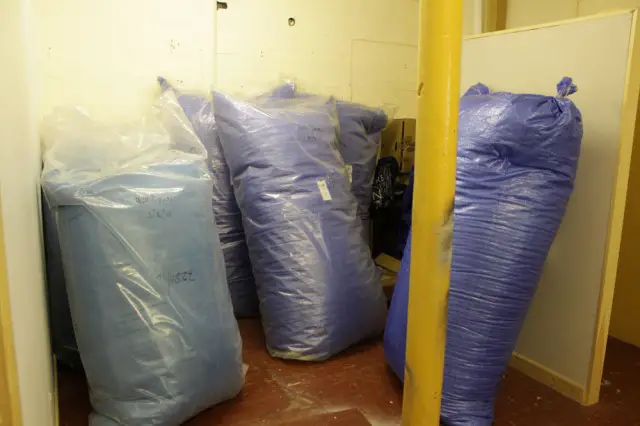
The system of a down: 600 fill down, 800 fill? What does that all mean? The numbers originally came as a warmth (well, loft) to weight measurement and are meant to represent the amount of cubic inches an ounce of measured down lofts up to. It’s now done a little very precisely and PHD has the only machine in the UK for measuring loft.
First the sample down is left to loft in a closed container for a week to achieve maximum loft (never store your sleeping bag tightly packed in a stuffsack if you want it to keep its loft…) and then a precise amount (30g) is weighed out and put into the ‘Loftermeasuriser’ – I made that up as I can’t remember the name… The down is then given a controlled blast of air to make sure that it’s equally distributed through the container. Finally the lid is lowered and where it comes to rest is measured and compared to a chart of lofts.
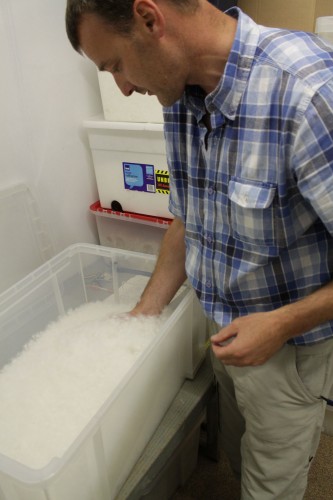
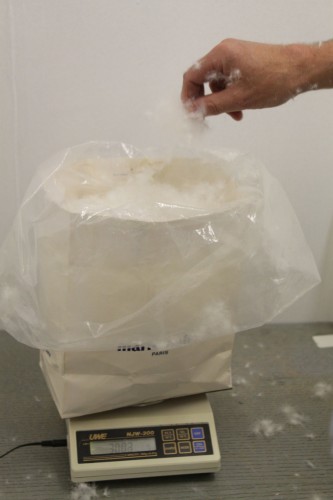
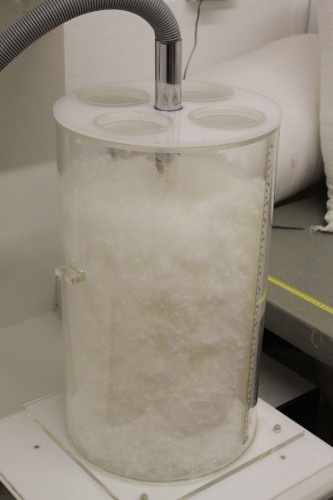
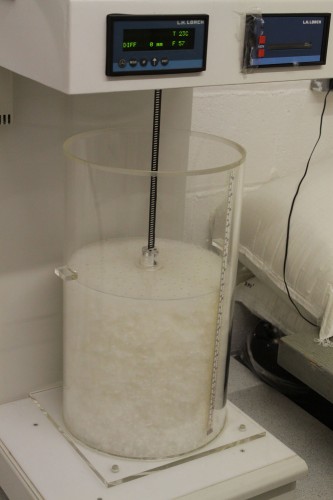
Then, at Peter Elliot puts it “…the internet came along and let us sell to the world.”
PHD had arrived. Now it sells to 98 countries.
In the summer almost all PHD’s gear is made to order. The tiny stock cupboard there holds a bare minimum of stock of popular items. Seeing as all of its sleeping bags are custom orders, it’s not surprising to see few in stock (they come in large, XL, short, slim, extra wide options, not to mention zip options, hoods, baffles and then you get to choose down weight, fabric and so on – in fact there are nine million different combinations of bag listed on its (surprisingly addictive…) build your own sleeping bag website: http://www.phdesigns.co.uk/dyosleepingbag/ (Though I’d turn the sound down if you don’t want the office filling with an Arctic tundra soundtrack)
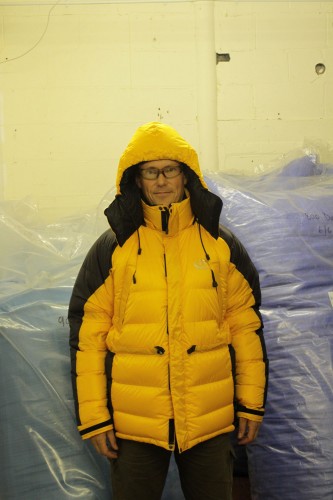
There are 20 people working at PHD these days, many of them have been working in the business for 40 years. When you place an order, this is printed out and given to one of the two Margarets. There are cardboard patterns for each size of every product and she will go and get the right one and mark and cut the fabric to that pattern. PHD has just hired a computer savvy fashion designer to plot and digitise this vast (not to mention flammable) precious asset to protect it.
Once the pattern has been cut, it’s sent to the sewing room where a collection of skilled seamstresses sew up the jacket, or bag or whatever to the pattern. Once this is sewn, it’ll be open-ended on one edge where it can be filled with down. This happens in the down room, where precise amounts of down are put into each baffle according to a large recipe book. This has a page for every size of every item and says things like: ‘Down jacket, size small, neck baffle – 7g of down, chest baffles 19g each’ and so on.
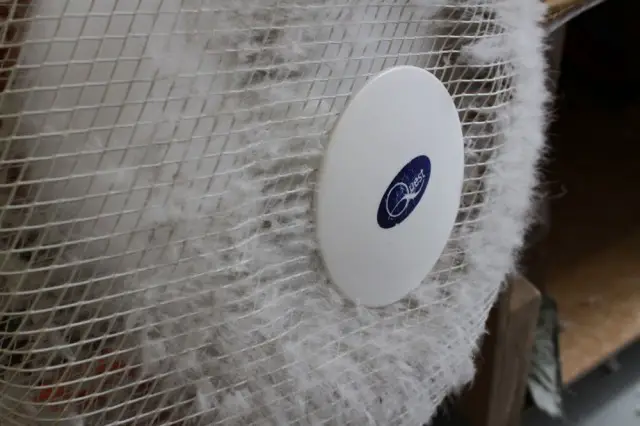
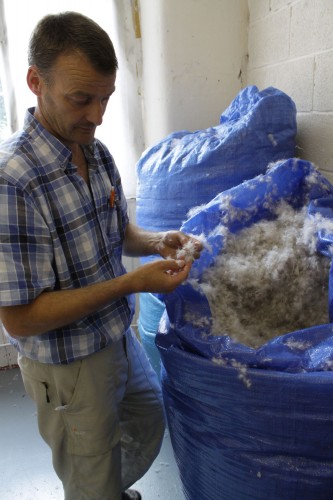
The filled jacket or bag is then returned to the sewing room, where it is final-stitched and finished. Then it’s bagged and ready to send. Given the amount of hand work that goes on, it’s not surprising that there’s usually a turnaround of 30 days from order to delivery. This is a far cry from walking in and buying a North Face jacket in a shop. Peter’s not dismissive about the big high street down brands. They do a good job at making warm jackets, but PHD is happy to take the customers who want specific gear for outdoor adventuring, jackets that weigh little and pack small, or sleeping bags that’ll go down to -50C with room to accommodate climbing boots inside them.
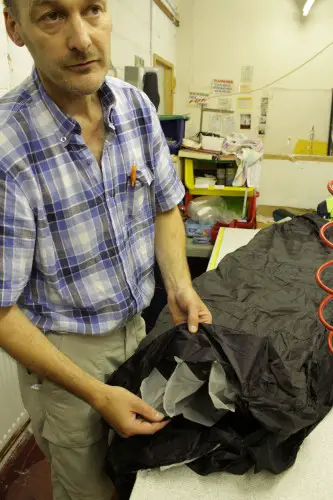
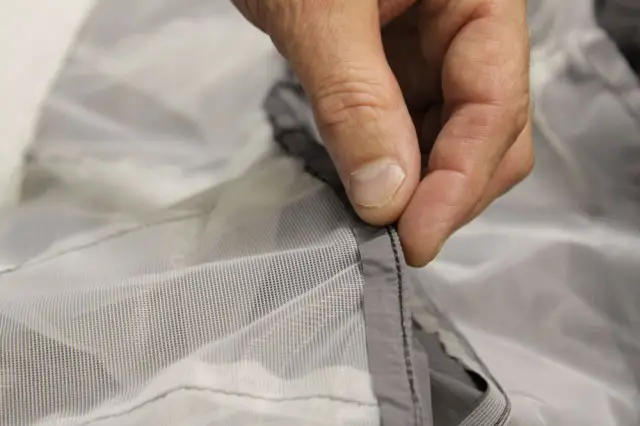
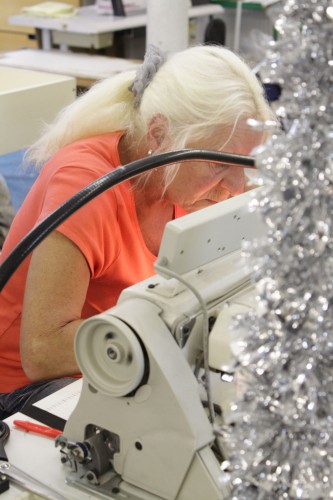
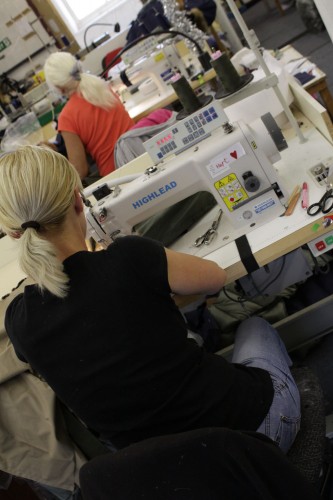
There’s also the flexibility to do crazy custom stuff and the walls of the small office are lined with thank-you letters and signed photos from mountain rescue teams, outdoor instructors and, perhaps surprisingly, actors and film crews. This is because much of outdoor filming involves standing around in the cold and PHD has supplied many a film crew with puffa jackets. They’ve gone further than that at times though, making a made-to-measure down coat that would fit over a hugely hooped Elizabethan dress for a period costume once to keep the actress laced into it warm between takes. It’s all possible…
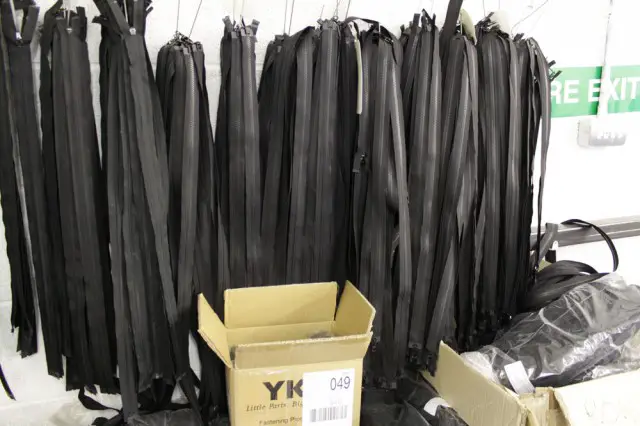
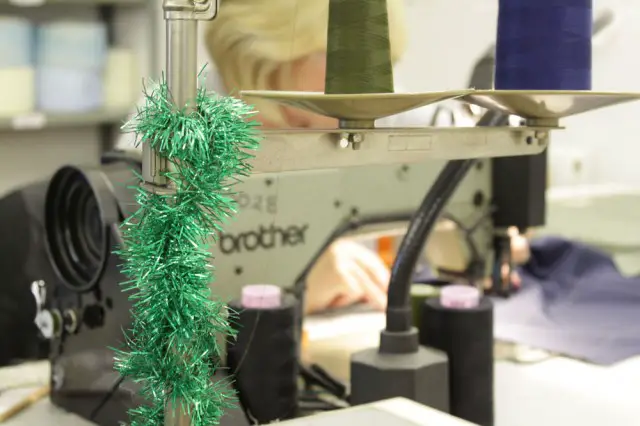
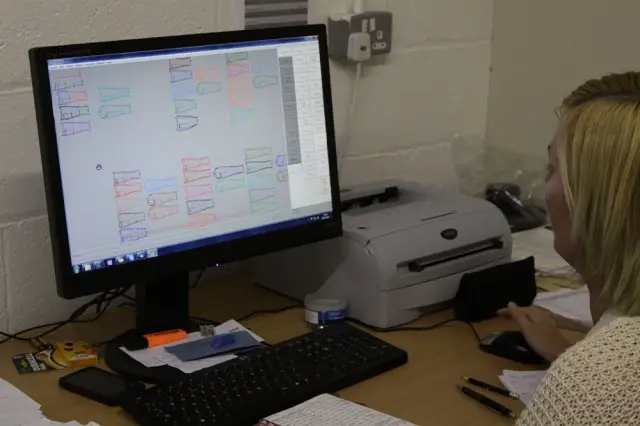

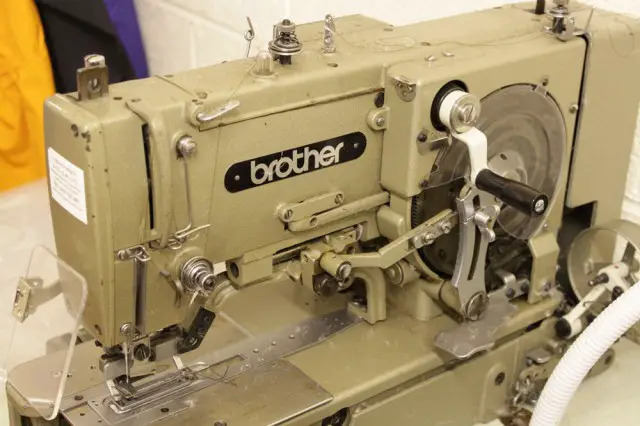
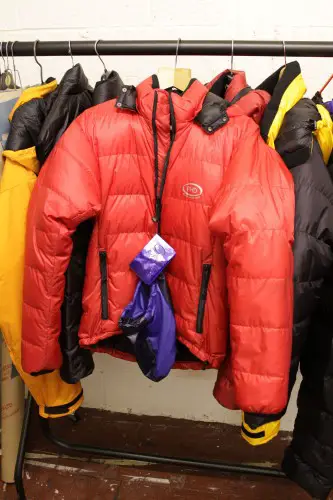
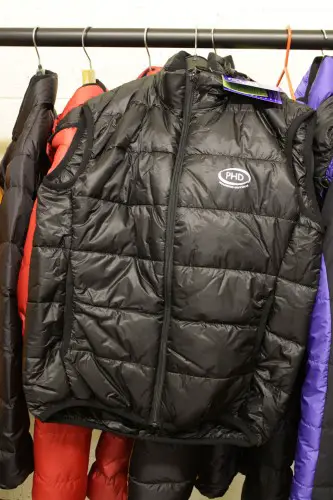
And so, after about five hours of talking and touring the factory, I left for my train, hugely impressed that a company with such a large amount of hand-work can survive and thrive in the UK still. As long as people keep adventuring in the outdoors and need to keep warm, I imagine that they’ll keep doing well. They (wisely) have no plans on becoming a high street fashion brand and they (equally wisely) don’t give out freebies to journalists and have-a-go ‘sponsor me’ expeditions. Their customers (many of whom have their measurements on file at PHD, or who are in weekly contact) know the value of the goods they’re buying and that the company wants nothing more than to make them stuff that’ll work in extreme conditions.
Right, I’m off to design a sleeping bag…
Links:
PHD – www.phdesigns.co.uk
Design your own sleeping bag – http://www.phdesigns.co.uk/dyosleepingbag/
Comments (18)
Leave Reply
Post Comment



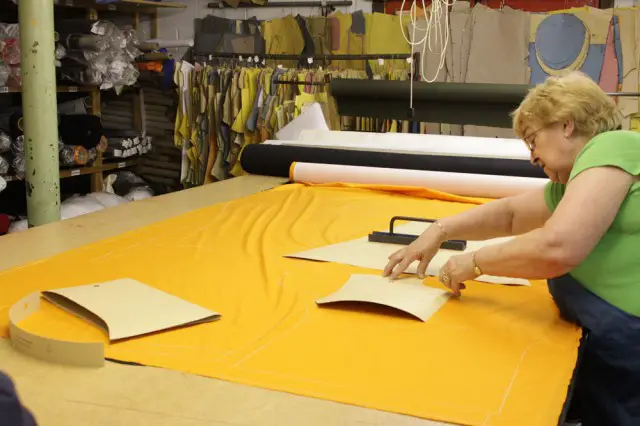
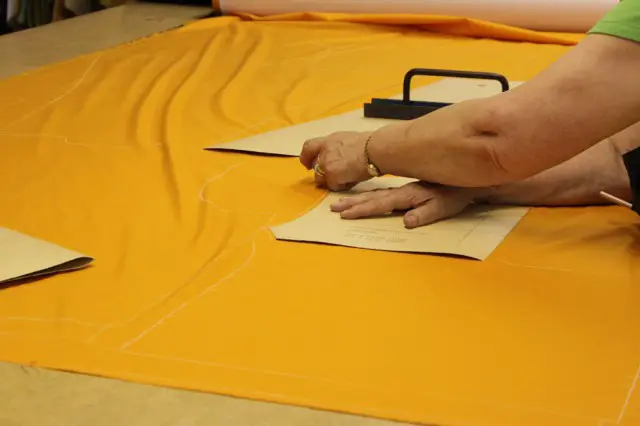
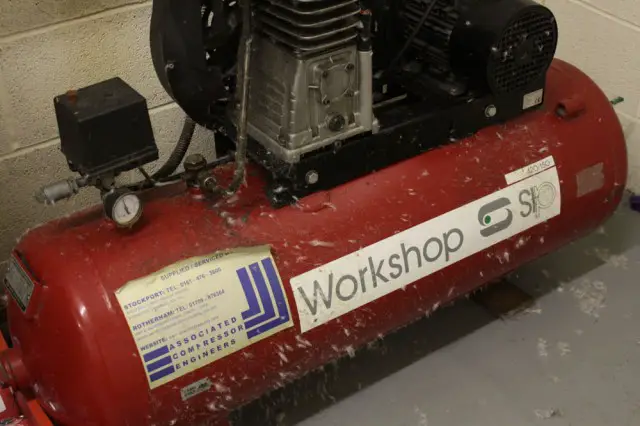
Fantastic stuff – and yes, want!
Articles like this are yet another reason I’m so happy to be a subscriber! Thanks!
Glad you liked it. I wasn’t sure if it was mainstream enough for the magazine, but it was certainly a story that needs to be told.
best article I’ve seen on here – gotta love PHD
Excellent, a much better story than a few lines on ‘things we got sent’. Great use of the website 🙂
Great write up, I have on of their Gilets its ace
Fab, I love seeing how stuff is made.
Yep, a great read.
Great to read stories of small uk companies who excel.
TAMESIDE
hth
{Fixed – Chipps}
Brilliant read, and a few questions answered.
I’ve still got my Mountain Equipment ultrafleece jacket from Pete’s days there – still gets worn!
Would love some phd stuff. Where’d I put my xmas list…….
Great article Chipps.. more of this please 🙂
Still remember going to the old Mountain Equipment factory about 20 years back. Their catalogue said there was a factory shop there – there wasn’t – but I still have the duvet jacket I bought that day and it came in jolly useful last winter.
A really interesting and enjoyable read, cheers Chipps
Still use me old ME Dewline down bag and jacket in the Alps.
Good article, cheers
Love it
great feature thanks. I own a custom PHD down bag and vest and they are fantastic pieces of ultralight kit. PHD as a company are great to deal with too.
I like it! A nice piece.
Great article.
Looking at those machines, fabrics (tinsel!) is just like being at work… except we have sequins, chiffon and other “poncy dresses” type fabric rather than the fun of down, primaloft and the like.